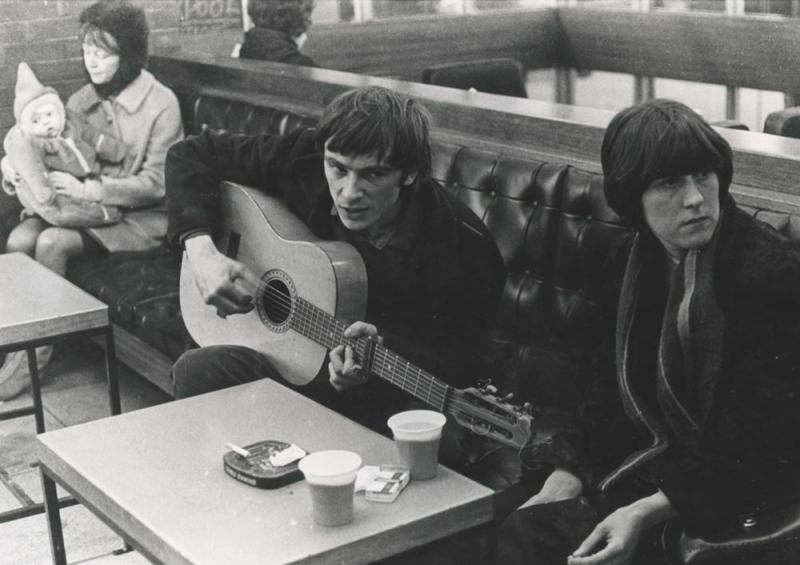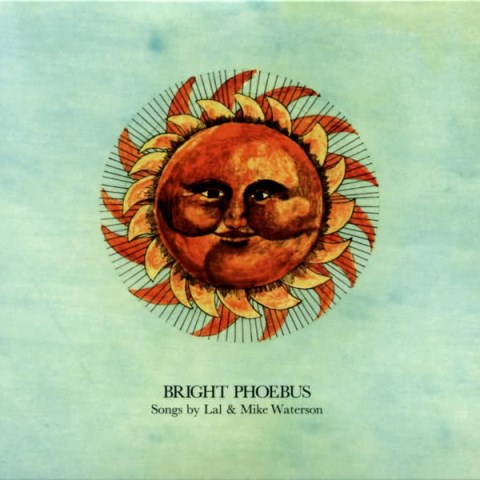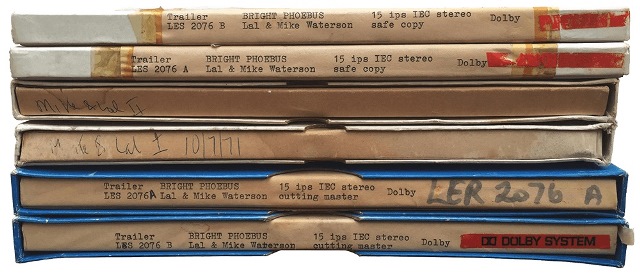Reissue CD of the Year: Lal & Mike Waterson | reviews, news & interviews
Reissue CD of the Year: Lal & Mike Waterson
Reissue CD of the Year: Lal & Mike Waterson
The singer-songwriter masterpiece ‘Bright Phoebus’ finally gets the treatment it deserves

In 1972, just 2000 copies of Bright Phoebus were pressed. Half were off-centre and unplayable. This year, the first conscientious reissue of the album hit 31 in the British album chart. Although it has been a cult favourite for the last couple of decades, the success was nonetheless surprising.
Bright Phoebus was credited as an album showcasing the songs of siblings Lal & Mike Waterson – it was not strictly by Lal & Mike Waterson. One of its 12 tracks, “Red Wine & Promises”, was sung by sister Norma Waterson, who had previously stood alongside them in The Watersons. Not conceived as a mainstream release, the album was a window into a world in which collaboration was endemic. More importantly, it was filled with great songs, each performed with an affecting directness. If this was a folk album, the quality of its songs evidenced its creators as singer-songwriters of the highest order.
 Musicians of various stripes have championed Bright Phoebus and tribute shows to the album – under the Bright Phoebus Revisited banner – were held in October 2013. Bob Davenport, Martin Carthy and Norma Waterson, all of whom were on the album, played. Jarvis Cocker and Richard Hawley appeared too, as did Lal’s children Marry Waterson and Oliver Knight. Lal and Mike Waterson were not there as they died in, respectively, 1998 and 2011.
Musicians of various stripes have championed Bright Phoebus and tribute shows to the album – under the Bright Phoebus Revisited banner – were held in October 2013. Bob Davenport, Martin Carthy and Norma Waterson, all of whom were on the album, played. Jarvis Cocker and Richard Hawley appeared too, as did Lal’s children Marry Waterson and Oliver Knight. Lal and Mike Waterson were not there as they died in, respectively, 1998 and 2011.
One other reissue this year has had the same impact as Bright Phoebus: World Spirituality Classics, Volume 1: The Ecstatic Music of Alice Coltrane Turiyasangitananda. Each album shares the traits setting an essential reissue apart: the telling and contextualising of a story which has not been told before to celebrate great, individual music which had hitherto largely gone unlauded. Importantly, both releases were diligently put together with a keen eye to enhancing what was being reissued with the best possible package.
The Alice Coltrane collection has already been covered in Reissue CDs Weekly so Bright Phoebus picks up the Reissue CD of the Year tag. However, although it was issued as a silver disc, the version of the Waterson's album to go for is the double-album configuration as the format complements the timelessness of the music and is as close as it will get to a properly made copy of the original album.
An awful-sounding 2000 CD edition was available, so the new reissue plugs a major gap even though first pressings on the Trailer label aren’t that expensive and – off-centre or not – sell for between £80 and £130. The new, Waterson-family approved edition of Bright Phoebus is supplemented by a bonus album of 1971 demo recordings, some of which were heard on the 2013 Lal Waterson archive compilation Teach me to be a Summer's Morning. Remastering from the album's original master tapes (pictured below left) has brought an uncanny immediacy.
Although Bright Phoebus has to be listened to as album – from beginning to end, first Side One and then Side Two – a shortcut to its soul can be taken by heading for the unsettling “The Scarecrow”, a crystalline yet oblique tale of seeing beyond physical and surface manifestations: a lover is found to be nothing more than a bag of bones.
 In general, Lal and Mike’s songs were distinct from each other. Hers were allusory, delivered in a portent-infused voice and akin to the creepy “The Scarecrow”. Darkness and foreboding were never far. His were laconic and (relatively) upbeat observations on the day-to-day world as he saw it. Mike’s album opener “Rubber Band” is a wry comment on the pop process. “Just like margarine our fame is spreading,” he sings. This said, the Norma-sung, Lal-written “Red Wine Promise” is about the effects of being drunk. By having Norma sing the song Lal kept a step removed from its subject, just as she had with the allusiveness inherent in the songs she herself sang.
In general, Lal and Mike’s songs were distinct from each other. Hers were allusory, delivered in a portent-infused voice and akin to the creepy “The Scarecrow”. Darkness and foreboding were never far. His were laconic and (relatively) upbeat observations on the day-to-day world as he saw it. Mike’s album opener “Rubber Band” is a wry comment on the pop process. “Just like margarine our fame is spreading,” he sings. This said, the Norma-sung, Lal-written “Red Wine Promise” is about the effects of being drunk. By having Norma sing the song Lal kept a step removed from its subject, just as she had with the allusiveness inherent in the songs she herself sang.
With Lal, Mike and Norma, Bright Phoebus was, to great degree, an album by a reunited Watersons. The family rooted group’s last album was issued in 1966 and they had not performed live since 1968. It was a comeback. Unlike before, it was not vocal only and featured self-composed rather than traditional material. Press reviews were positive yet, according to Martin Carthy in the new reissue’s authoritative liner notes, live appearances on the back of its release generated comments from audience members such as “what are you singing that crap for.” Some inflexible folkies wanted the old Watersons.
Nonetheless, Bright Phoebus had not quite come from the blue. There was a recent precedent. Anne Briggs had sung with The Watersons and was party to Lal writing her own songs. Briggs’ 1971 album The Time Has Come included a version of “Fine Horsemen”, also recorded the next year for Bright Phoebus. Briggs, like The Watersons, was known as an unaccompanied singer and The Time Has Come represented a fresh agenda by setting instrumental accompaniment alongside her voice – just like Bright Phoebus. The Watersons and Anne Briggs were recognised as interpreters of traditional material and both albums challenged this by featuring new, original songs. It is now clear that no one in 1972 was thinking about Briggs and how The Time Has Come reverberated through Lal and Mike Waterson's new album.
The driver behind getting the spikey Bright Phoebus off the ground was Martin Carthy who, playing Hull in 1971, called on Lal and was floored by the new songs she sang to him. He told fellow Steeleye Span member Ashley Hutchings that they had to be heard. Hutchings organised the album sessions, which commenced on 16 May 1972. Carthy, Tim Hart, Hutchings, Dave Mattocks, Maddy Prior and Richard Thompson all played and sang. Bright Phoebus ties in with their bands The Albion Band, Fairport Convention and Steeleye Span, as well as Anne Briggs’ The Time Has Come. But, still, Lal and Mike Waterson's creation stood apart. An album this intense, this unvarnished was not going to easily find its niche.
- Next week: To the Outside of Everything – box set dedicated to UK post-punk
- Read more reissue reviews on theartsdesk
Explore topics
Share this article
The future of Arts Journalism
You can stop theartsdesk.com closing!
We urgently need financing to survive. Our fundraising drive has thus far raised £49,000 but we need to reach £100,000 or we will be forced to close. Please contribute here: https://gofund.me/c3f6033d
And if you can forward this information to anyone who might assist, we’d be grateful.

Subscribe to theartsdesk.com
Thank you for continuing to read our work on theartsdesk.com. For unlimited access to every article in its entirety, including our archive of more than 15,000 pieces, we're asking for £5 per month or £40 per year. We feel it's a very good deal, and hope you do too.
To take a subscription now simply click here.
And if you're looking for that extra gift for a friend or family member, why not treat them to a theartsdesk.com gift subscription?
more New music
 Benson Boone, O2 London review - sequins, spectacle and cheeky charm
Two hours of backwards-somersaults and British accents in a confetti-drenched spectacle
Benson Boone, O2 London review - sequins, spectacle and cheeky charm
Two hours of backwards-somersaults and British accents in a confetti-drenched spectacle
 Midlake's 'A Bridge to Far' is a tour-de-force folk-leaning psychedelic album
The Denton, Texas sextet fashions a career milestone
Midlake's 'A Bridge to Far' is a tour-de-force folk-leaning psychedelic album
The Denton, Texas sextet fashions a career milestone
 'Vicious Delicious' is a tasty, burlesque-rockin' debut from pop hellion Luvcat
Contagious yarns of lust and nightlife adventure from new pop minx
'Vicious Delicious' is a tasty, burlesque-rockin' debut from pop hellion Luvcat
Contagious yarns of lust and nightlife adventure from new pop minx
 Music Reissues Weekly: Hawkwind - Hall of the Mountain Grill
Exhaustive box set dedicated to the album which moved forward from the ‘Space Ritual’ era
Music Reissues Weekly: Hawkwind - Hall of the Mountain Grill
Exhaustive box set dedicated to the album which moved forward from the ‘Space Ritual’ era
 'Everybody Scream': Florence + The Machine's brooding sixth album
Hauntingly beautiful, this is a sombre slow burn, shifting steadily through gradients
'Everybody Scream': Florence + The Machine's brooding sixth album
Hauntingly beautiful, this is a sombre slow burn, shifting steadily through gradients
 Cat Burns finds 'How to Be Human' but maybe not her own sound
A charming and distinctive voice stifled by generic production
Cat Burns finds 'How to Be Human' but maybe not her own sound
A charming and distinctive voice stifled by generic production
 Todd Rundgren, London Palladium review - bold, soul-inclined makeover charms and enthrals
The wizard confirms why he is a true star
Todd Rundgren, London Palladium review - bold, soul-inclined makeover charms and enthrals
The wizard confirms why he is a true star
 It’s back to the beginning for the latest Dylan Bootleg
Eight CDs encompass Dylan’s earliest recordings up to his first major-league concert
It’s back to the beginning for the latest Dylan Bootleg
Eight CDs encompass Dylan’s earliest recordings up to his first major-league concert
 Ireland's Hilary Woods casts a hypnotic spell with 'Night CRIÚ'
The former bassist of the grunge-leaning trio JJ72 embraces the spectral
Ireland's Hilary Woods casts a hypnotic spell with 'Night CRIÚ'
The former bassist of the grunge-leaning trio JJ72 embraces the spectral
 Lily Allen's 'West End Girl' offers a bloody, broken view into the wreckage of her marriage
Singer's return after seven years away from music is autofiction in the brutally raw
Lily Allen's 'West End Girl' offers a bloody, broken view into the wreckage of her marriage
Singer's return after seven years away from music is autofiction in the brutally raw
 Music Reissues Weekly: Joe Meek - A Curious Mind
How the maverick Sixties producer’s preoccupations influenced his creations
Music Reissues Weekly: Joe Meek - A Curious Mind
How the maverick Sixties producer’s preoccupations influenced his creations

Add comment